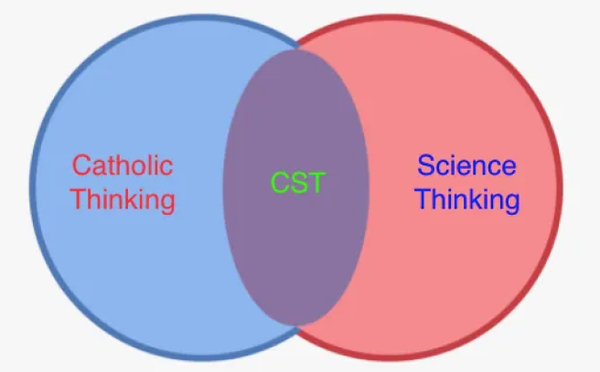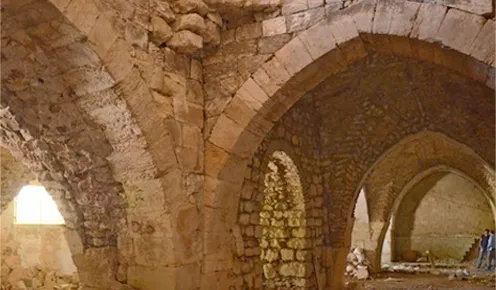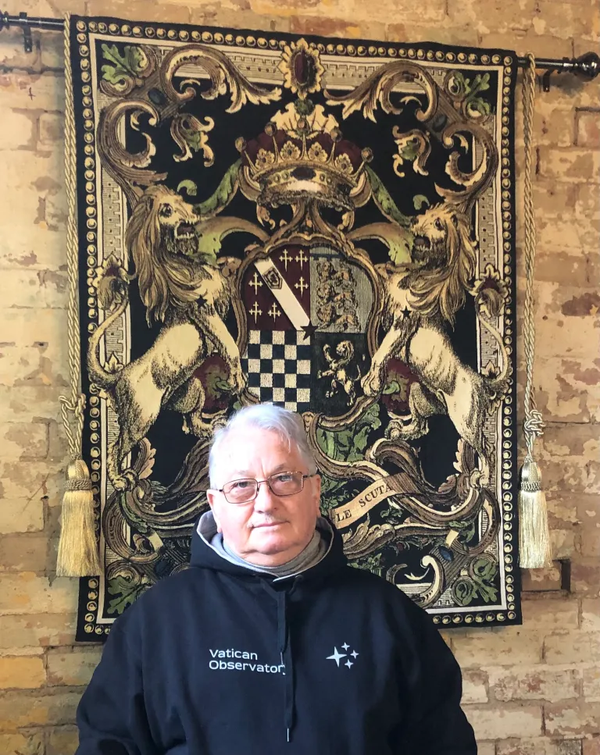CONTACT BY EMAIL: CLICK HERE
As a scientist I have often wondered why, for many people, there seems to be a conflict between science versus religion.
Not just a fake conflict but a real conflict.
Yet, there is much evidentiary value in what these long-established cultures (religion and science) have in common. There is overlap.

One example; humans have always had to deal with uncertainty. Uncertainty about the past. Uncertainty about the future. And, for most of us, uncertainty about what is currently going on in our world today.
Human thinking has evolved both religion and science as ways to cope with uncertainty. Religion can use faith. Science can use doubt. Both cognitive solutions have proved to be very effective in the human brain.
In particular, because of my personal tradition and education I have wondered about the conflict between Catholic Thinking versus Science Thinking. Is there a real conflict? Are they fundamentally at odds? If not, what to do about it?
I believe that it’s probably less of a conflict and more of a misunderstanding. Or, some say ‘conflict theory’ has likely been a quirk of deception more recent in history (excellent podcast here).
In my experience, the conflict is not between Catholic Thinking vs Science Thinking. No. The conflict is between truth-owning vs truth-seeking. Owning Truth and defending it against mutation is not the same as searching for Truth in order to get closer to it. These are two different truth strategies that indeed are often at odds.
They needn’t be.
The misunderstanding is about the concept of Truth. In human thinking is Truth a bequest or a quest? Or, a mix of both?
This problem exists both in religion and science. The Nobel Physicist, Max Planck, famously said, “A new truth does not triumph by convincing its opponents and making them see the light but rather because opponents eventually die and then a new generation grows up that is familiar with it”.
I’ve enjoyed many discussions on questions like these with scientists, theologians and with a few brilliant thinkers who are both.
Australian emeritus science thinker, Sir Gus Nossal, recently described the CST idea as “thoughtful, provocative and very original. I agree that Catholic Thinking can overlap with Science thinking”.

After many years of research and writing on the topic I’ve been working on a project to draw attention to an alternative to the ‘science vs religion’ binary view. We need to go beyond versus to and. Science + Religion.
What is needed is an escape from the black/white view to a much better view … a bvs.
I call this new area for research and discussion: CST or Catholic Science Thinking. The work has led to a new SOT project being launched today. It is a new CST school for those who may be interested in exploring Catholic Science Thinking.
CST is, in fact, a very interesting topic drawing down, as it does, on 20 centuries of Catholic Thinking and 4 centuries of Science Thinking and how these two cultures have generated innovations that have changed world history and human lives in so many ways.
For example, Science Thinking has given us genetics, memetics, vaccination, cyberspace, EHT, AI, CERN, has put a helicopter on Mars, and the cosmogonic Big Bang Theory with an abundance of supporting quantum evidence; and Catholic Thinking gave us Christmas, The Vatican Archives, and missionaries, it established universities and invented the idea of universal education (currently over 220,000 schools) and (anticipating the internet), it virally used missionaries (influencers) to spread it around the world along with many thousands of gratuitous scientific institutes, archeological research foundations and libraries.
Also, most people don’t know that the Catholic Church is the largest health-provider in the world. It has around 18,000 clinics, 16,000 homes for the elderly and those with special needs, and 5,500 hospitals. 65% of them are located in developing countries.
Catholic culture also offers workers many holidays, family festivals, special ceremonies for passages of life, art and music and, of course, Sunday Mass at local community chapels, churches and cathedrals.

| A recent finding in the Old City of Jerusalem has unearthed the ruins of what is now considered to be the Order of St. John’s first hospital, dating back more than 900 years. |
It would, of course, be interesting to see the same kind of research applied to science and Buddhist Thinking or Persian Thinking or Confucian Thinking and so on and perhaps others might take it up.
What is CST?
Perhaps first it’s useful to say what CST is not. Catholic Science Thinking is not thinking about Catholic Science. Why? Because there’s no such thing as ‘Catholic Science’.
Science is science.
There’s no Catholic Science or Japanese Science or Silicon Valley Science and so on. Science is universal. It’s either science or it’s not science.
So, to explore CST we have opened the Pope Luciani School of Catholic Science Thinking. We teach discernment as a skill.
The new Luciani School is a school of thinking. It’s not a school of thought. It’s a school for thinking about Catholic Thinking and Science Thinking and exploring how and where these two thinking traditions may overlap even for their mutual benefit.

“Catholic is universal. Science is universal.”
– Dr Michael Hewitt-Gleeson
CONTACT BY EMAIL: CLICK HERE
To dive deeper you can visit the new CST school here …
